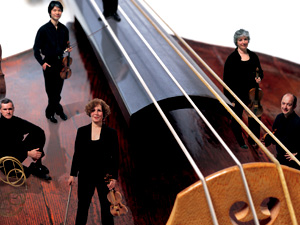Symphonic 'Enlightenment' In The 18th Century

The Orchestra of the Age of Enlightenment specializes in 18th-century music.
Concert Program
Hear pieces from the concert separately.
Mozart: Divertimento in D, K. 136
[15 min 28 sec] add
C.P.E. Bach: Symphony in B minor
[10 min 57 sec] add
J. Haydn: Violin Concerto in C major
[20 min 28 sec] add
The Orchestra of the Age of Enlightenment, in concert in St. Paul, Minn.
APM, April 15, 2009 - We're used to thinking of the 20th century as the high point of technological and cultural change. The case is easy to make: A generation which knew the horse and buggy watched Neil Armstrong's moon walk. There was Einstein, two world wars, a smallpox vaccine, Elvis Presley and laptop computers.
But two and a half centuries ago, subtler dramas of ideas led to upheavals every bit as volcanic as our recent spectacles. The London-based Orchestra of the Age of Enlightenment specializes in the soundtrack of this time. And the ensemble recently made its case for nuanced but significant musical revolutions in works by Mozart, Haydn, and C.P.E. Bach.
Mozart wrote his Divertimento in D, K. 136 at age 16. We hear the charming and graceful prodigy announcing his genius — a familiar, even comforting sound. But rebellion lurks beneath the surface: This teenager is out to change things. He abruptly wrenches the complacent listener from one key to another. And those clever turns of phrase, are they really quite polite?
Carl Philipp Emmanuel Bach was another disturber of the peace. Superbly trained by his father, this second son of Johann Sebastian had his own things to say. His style was expressive, even stormy, with no built-in impedance against the display of human emotions. This symphony in B minor, with its stabbing rhythms and dissonance, gives us a forward-thinking C.P.E. Bach in the year 1773.
Again, it might take an act of the imagination to hear the danger in this music today, but the rules of proportion and procedure in a coherent world were being ignored. Such breaches might be a prelude to anything: the rights of man, anarchy, bewigged noblemen hogtied in tumbrils awaiting guillotines.
Finally, Rachel Podger is the soloist in Joseph Haydn's Violin Concerto in C. Another innovator, and an inventor of lasting things, Haydn developed both the string quartet and the symphony. On the surface, his style in the Concerto says "Empress Maria Theresia," but the virtuosic solo part anticipates the humanity of Beethoven and Brahms. These men — living after the Reigns of Terror and the Napoleonic promise and nightmare — inherited the Haydn legacy of change and then felt it accelerate.
Trains broke the 25 mph barrier in the 1830s. This was too much, and Cassandras in the press warned, "The end is near!" Our shifts — from slide rule to nanotechnology, from Kitty Hawk to the Mars Rover — have conspired to make change almost routine. Can we ever again know the equivalent shock of a C.P.E. Bach symphony?
I saw this article on NPR's website last night, and although it doesn't specifically address 20th century Amercian ingenuity, it reminded me of our continuing discussion of innovation vs tradition.
ReplyDeleteMost striking was the difference in the scale of innovation in 18th century music as apposed to 20th century compositions. As the article states, subtler aspects of musical change, composing for a quartet of strings for example, would have been as earth shattering as Harry Partch's collection of homemade instruments.
It is interesting to note how dramatic advances in science and technology as well as rapid upheavals of social norms are reflected in art. The pace of change and innovation in the 20th century had quickly accelerated compared to previous ages. Have we reached a point where subtlety no longer has a place in innovation? Has innovation become a process of continuously and completely reinventing the wheel?
Never in a million years would I have thought that this music would engage me as much as it has over the past year. I was first introduced to the ensemble by my ex-boyfriend who is an ad hoc violist with the ensemble (and may I interject my pride for the accomplishments of a fellow South Africa). His inspired experiences forced me to take time and listen to samples of their concerts.
ReplyDeleteCould repost the links that you provided, I can't seem to access them. Thank you for sharing this obvious example of 'innovation' and 'tradition'
I'm going to repost the link to the website. It should be easier to access from NPR's website. Just copy and paste into your browser.
ReplyDeletehttp://www.npr.org/templates/story/story.php?storyId=103130363
You know, I experienced a similar revelation about the power of subtle changes earlier this very morning. In my MUS 504 19th Century Music class, we looked at Brahms' Second Symphony and spent much time discussing his indebtedness to Schubert for the use of a three-key exposition to the first movement. The symphony opens in D, then modulates not to A, the dominant, but to f# minor, it's relative minor. Finally, at the end of the exposition, the second theme is presented in the "correct" key of A.
ReplyDeleteAt the time, all I could think was something along the lines of "Well, la-dee-FRICKIN'-da! If that's the most interesting thing in this movement, then this class is going to go by VERY SLOWLY."
So I tried to make myself appreciate how this little harmonic trick can really throw off the listener (and the theorist). After all, it works for Beethoven in the first movement of the "Waldstein" piano sonata. And I think that, generally, I do love subtlety in music. But it was a wake-up call for me.
So maybe it's in the audience where subtlety is losing ground, not in the composer's work.